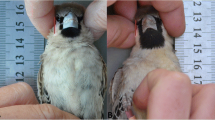Abstract
We test the hypothesis that the relationship between networks resulting from unresolved agonistic interactions (URI) and social dominance was context-dependent in a captive group of American Flamingos (Phoenicopterus ruber ruber). URI formed networks that differed substantially from the dominance network and depended on the context in which the interactions occurred. Betweenness centrality in the URI network on the region (“the island”) where nesting took place was strongly correlated with dominance score. This correlation was particularly strong in the case of males, but, in both sexes, the dominant individual in a dyad was likely to have a higher betweenness centrality in the island URI. On the other hand, betweenness centrality in URI networks at the feeder did not show any relationship with dominance, but was associated with observed visits to the feeder. Thus, centrality in both the island URI network and the feeder URI network was associated with access to a resource over which individuals competed. Along with other results suggesting that non-dominance interactions may form social networks distinct from, but related to, dominance networks, our results support the hypothesis that relationships within animal social groups can be modeled as a series of distinct but inter-related networks.







Similar content being viewed by others
References
Anderson MJ, Williams SA, Bono AJ (2010) Preferred neck-resting position predicts aggression in Caribbean flamingos (Phoenicopterus ruber). Laterality 15:629–638
Arengo F, Baldassarre GA (1995) Effects of food density on the behavior and distribution of nonbreeding American flamingos in Yucatan, Mexico. Condor 97:325–334
Barrett L, Henzi SP, Lusseau D (2012) Taking sociality seriously: the structure of multi-dimensional social networks as a source of information for individuals. Philos Trans R Soc Lond B 367:2108–2118
Bildstein KL, Frederick PC, Spalding MG (1991) Feeding patterns and aggressive behavior in juvenile and adult American flamingos. Condor 93:916–925
Bildstein K, Golden CB, McCraith BJ, Bohmke BW, Seibels RE (1993) Feeding behavior, aggression, and the conservation biology of flamingos: integrating studies of captive and free-ranging birds. Am Zool 33:117–125
Cassinello J, Pieters I (2000) Multi-male captive groups of endangered dama gazelle: social rank, aggression, and enclosure effects. Zoo Biol 19:121–129
Croft DP, James R, Krause J (2008) Exploring animal social networks. Princeton University Press, Princeton
De Nooy W, Mrvar A, Batagelj V (2005) Exploratory social network analysis with Pajek. Cambridge University Press, Cambridge
De Vries H (1995) An improved test of linearity in dominance hierarchies containing unknown or tied relationships. Anim Behav 50:1375–1389
De Vries H, Stevens JM, Vervaecke H (2006) Measuring and testing the steepness of dominance hierarchies. Anim Behav 71:585–592
Gallet É (1949) Les flamants roses de Camargue. Payot, Lausanne
Hemelrijk CK (1990) Models of, and tests for, reciprocity, unidirectionality and other social-interaction patterns at group level. Anim Behav 39:1013–1029
Hinton MG, Bendelow A, Lantz S, We TW, Schoen L, Brockett R, Kurubian J (2013) Patterns of aggression among captive American flamingos (P. ruber). Zoo Biol 32:445–453
Hogan ES, Houpt KA, Sweeney K (1988) The effect of enclosure size on social interactions and daily activity patterns of the captive Asiatic wild horse (Equus przewalskii). Appl Anim Behav Sci 21:147–168
Hughes AL, Raynes A, Driscoll C, Babler J (2013) Behavioral correlates of post-breeding weight change in a captive flock of American flamingos (P. ruber ruber). Zoo Biol 32:204–209
Johnson A, Cézilly F (2007) The greater flamingo. Poyser, London
Kahl MP (1975) Ritualized displays. In: Kear J, Duplaix-Hall N (eds) Flamingos. Poyser, Berkhamsted, pp 142–149
King AJ, Douglas CM, Huchard E, Isaac NJ, Cowlishaw G (2008) Dominance and affiliation mediate despotism in a social primate. Curr Biol 18:1833–1838
Landau HG (1951) On dominance relations and the structure of animal societies: I. Effect of inherent characteristics. Bull Math Biophys 13:1–19
Madden JR, Drewe JA, Pearce GP, Clutton-Brock TH (2009) The social network structure of a wild meerkat population: 2. Intragroup interactions. Behav Ecol Sociobiol 64:81–95
Madden JR, Drewe JA, Pearce GP, Clutton-Brock TH (2011) The social network structure of a wild meerkat population: 3. Position of individuals within networks. Behav Ecol Sociobiol 65:1857–1871
Proulx SR, Promislow DE, Phillips PC (2005) Network thinking in ecology and evolution. Trends Ecol Evol 20:345–353
Rendón MA, Garrido A, Ramírez JM, Rendón-Martos M, Mat JA (2001) Despotic establishment of breeding colonies of greater flamingos, P. ruber, in southern Spain. Behav Ecol Sociobiol 50:55–60
Schein MW (1975) Social hierarchy and dominance. Dowden, Hutchinson, and Ross, Stroudsburg
Schmitz RA, Baldassarre GA (1992) Contest asymmetry and multiple bird conflicts during foraging among nonbreeding American flamingos in Yucatan, Mexico. Condor 94:254–259
Scott J (2013) Social network analysis. Sage, Los Angeles
Thompson WL (1960) Agonistic behavior in the House Finch. Part II: factors in aggressiveness and sociality. Condor 62:378–402
Val-Laillet D, Guesdon V, von Keyserlink MA, de Passille AM, Rushen J (2009) Allogrooming in cattle: relationships between social preferences, feeding displacements and social dominance. Appl Anim Behav Sci 116:141–149
Wey T, Blumstein DT, Shen W, Jordán F (2008) Social network analysis of animal behavior: a promising tool for the study of sociality. Anim Behav 75:333–344
Whitehead H (2008) Analyzing animal societies: quantitative methods for vertebrate social analysis. University of Chicago Press, Chicago
Acknowledgments
We are grateful to the Riverbanks Zoo Bird Department and Hospital staff for their work in weighing and managing the birds, especially: Colleen Lynch, Curator of Birds; Kate-Lyngle Cowand, senior bird keeper; Christine Talleda, bird keeper; Keith Benson DVM, senior veterinarian; and Cora Singleton DVM, associate veterinarian. Jenna Babler, Dan Merino, Amber Raynes, and Makeira Simmons assisted with observations.
Author information
Authors and Affiliations
Corresponding author
Electronic supplementary material
Below is the link to the electronic supplementary material.
About this article
Cite this article
Hughes, A.L., Driscoll, C. Being in the thick of things: context-dependent network centrality in a captive flock of American flamingos. J Ethol 32, 83–90 (2014). https://doi.org/10.1007/s10164-014-0398-0
Received:
Accepted:
Published:
Issue Date:
DOI: https://doi.org/10.1007/s10164-014-0398-0




